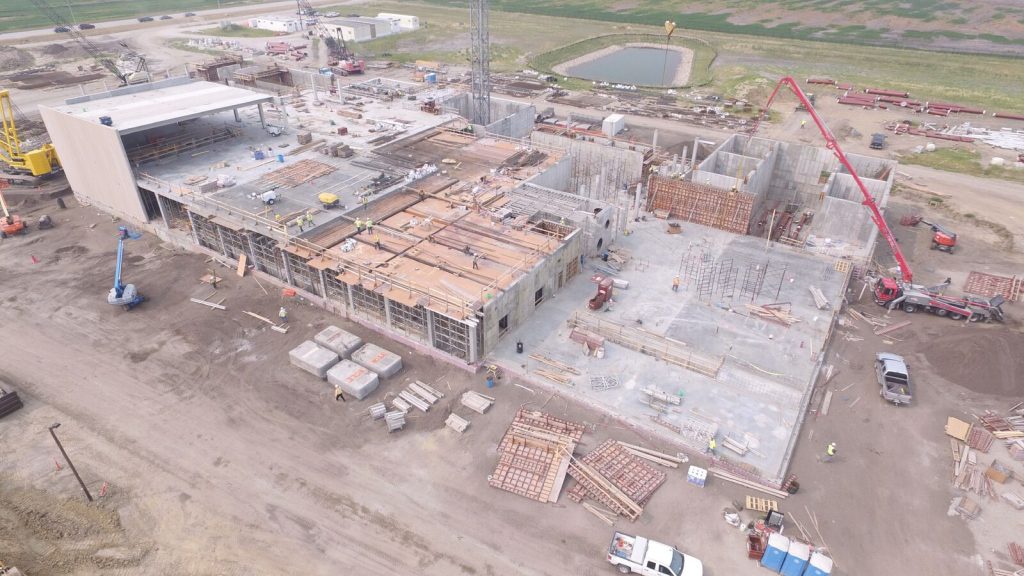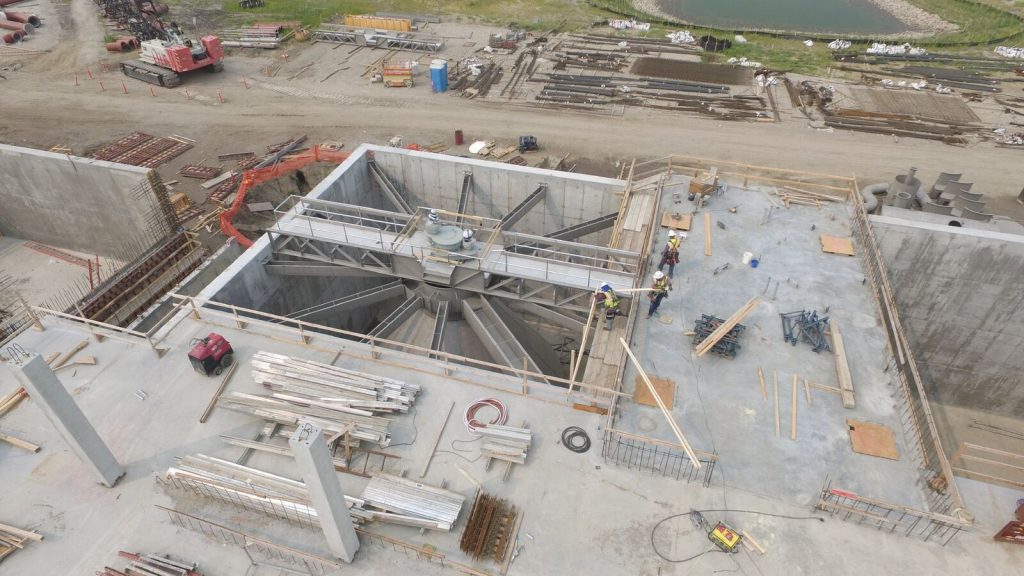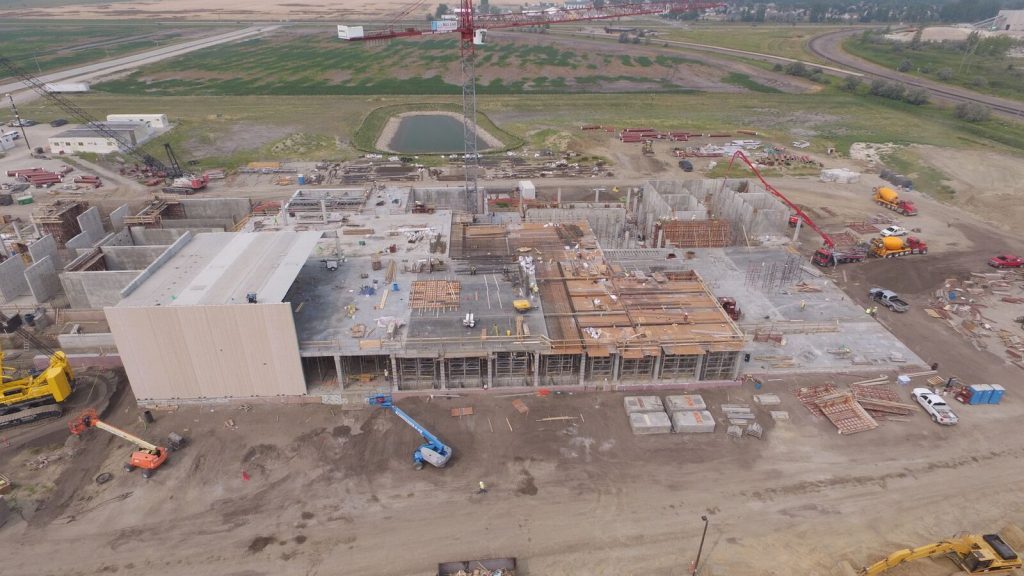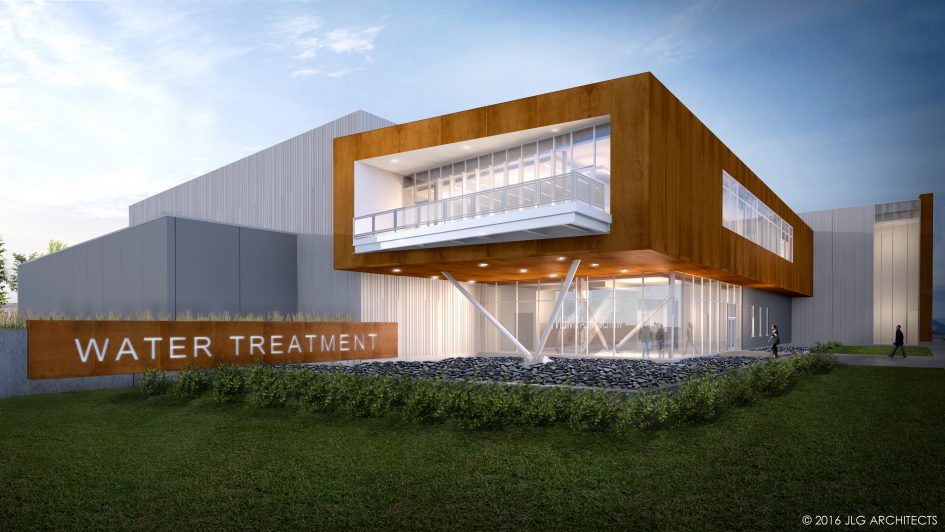Construction of the state-of-the-art, greenfield Grand Forks Regional Water Treatment Plant (GFRWTP) project is more than halfway complete, as of the fall of 2018. To date, the pile foundation system supporting the 100,000 ton facility is installed and 19,500 of 23,500 cubic yards of structural concrete have been placed. Construction of the precast concrete building shell began in August 2018, and the building is expected to be fully enclosed in November of 2018. Also, major treatment equipment, process piping, and mechanical equipment installation is ongoing as materials and equipment are delivered, and electrical construction is underway.

GFRWTP construction site looking northwest. Photo courtesy: CMAR Joint Venture of Construction Engineers-Ulliman Schutte Construction.
The new GFRWTP will serve the City of Grand Forks, Grand Forks Air Force Base, Grand Sky Development, and provide a backup water supply to the Grand Forks Traill Rural Water District. The $152 million project is the last piece of the puzzle in the City’s overall Water Concept Plan. The Concept Plan was developed following the devastating flood of 1997, when much of the City’s infrastructure, including the existing Grand Forks Water Treatment Plant, was inundated and damaged by floodwaters.
Prior to breaking ground on the GFRWTP project in December 2016, the City completed $52 million in water system improvements as part of the flood recovery process. The improvements included a new raw water intake facility, a seven million gallon clearwell and high service pump station, dual 30-inch water transmission pipelines from the existing site to the new clearwell, various distribution piping tie-back improvements, and treatment residual handling facilities.
The City of Grand Forks evaluated the feasibility of expanding and renovating the existing Plant, rather than constructing a brand-new facility. A feasibility study determined the existing site was limited for expansion, and the current layout wasn’t conducive to incorporating advanced treatment technologies such as ozonation and membrane treatment without significant modifications. In addition, the need to keep the existing Plant operational while significant renovations were underway meant increased construction costs and the potential for a regulatory infraction or periodic water rationing. Finally, the existing Plant is located in a residential neighborhood and historic district. Instead of focusing on renovating, the City decided to build a new facility on the northwest side of Grand Forks, in an industrial park area that is well suited for the scope and size of the facility and will serve the City and region for the next several decades.
The City selected the Construction Management at Risk (CMAR) project delivery method rather than the traditional design-bid-build model typically used for municipal projects. Substantial completion is slated for October 31, 2019, with final completion projected for June 30, 2020.

Installation of GFRWTP Softening Basin No.1 equipment. Photo courtesy: CMAR Joint Venture of Construction Engineers-Ulliman Schutte Construction.
The new facility will use advanced treatment technologies to provide high quality water at an increased capacity of 20 million gallons per day (MGD). The current Plant has a capacity of 16.5 MGD. “When the new Plant is complete, it will address mitigating downstream discharge impacts, increasing water demands, key regulatory challenges, and regional service integration,” says Melanie Parvey, Grand Forks Water Works Director.
“The new Grand Forks Regional Water Treatment Plant is designed to incorporate parallel conventional and membrane treatment trains. The conventional treatment train incorporates pretreatment, lime softening, recarbonation, ozonation, and biologically activated carbon (BAC) filtration. The membrane treatment train incorporates pretreatment, ultrafiltration (UF), and reverse osmosis (RO). When the flows from the conventional and membrane treatment trains combine, the pH is adjusted, and then the water flows through a chlorine/chloramine disinfectant contact basin,” explains Wayne Gerszewski, AE2S Project Manager.
“The parallel conventional and membrane treatment trains will address the ever-changing raw water quality challenges typical of the Red and Red Lake Rivers. I think residents will be very pleased because seasonal taste and odor events will be eliminated, and our operating team will be happy to have all the treatment tools on hand to address current and potential future regulatory compliance requirements,” says John “Fred” Goetz, Grand Forks Water Treatment Supervisor.
The GFRWTP effluent will flow by gravity to the seven million gallon clearwell that was constructed in preparation for the new GFRWTP, and an existing 24 MGD pump station will be used to pump the treated water to the City’s storage and distribution system.
The GFRWTP includes the following major improvements with respect to the existing Plant:
- Advanced Seasonal Treatment Operations – Operator selectable treatment paths will be utilized to address seasonal raw water quality changes and challenges.
- Custom Design of Chemical Feed System(s) – Lime silos contained within the building near the feed point to limit dry chemical transfer within the facility. All bulk, tote, and drum liquid chemicals are located within spill containment areas with readily accessible chemical pumping and injection points. Peristaltic feed pumps are standardized for all chemical feeds.
- Central Core Concept – Operation control, maintenance shop, and mechanical rooms are located near the center of the facility for efficient access. Electrical rooms are located near the equipment requiring the greatest loads.
- Personnel and Lab Areas – Designed for 24/7, 365-day operation. Incorporates staff offices, kitchen amenities, a training room, locker rooms, and full service organic and inorganic lab spaces.
- Trouble-Free Forklift Maneuvering – Forklift and scissor lift access to all floors and within required areas throughout the facility.
The new 212,000 square foot facility is about the same size as the existing Plant. However, the design of the new GFRWTP incorporates modular equipment for ease of expansion. This flexibility will allow the City to double the capacity in the future to 40 MGD, should the need arise.

GFRWTP and site overview looking north. Photo courtesy: CMAR Joint Venture of Construction Engineers-Ulliman Schutte Construction.
“This new Plant will take care of our current needs and we will be able to expand the facility as needed to accommodate our growing population and industrial water needs. I’m really pleased with how this project is shaping up. It’s going to benefit the City and region for the foreseeable and long term future,” says Todd Feland, Grand Forks City Administrator.
The City of Grand Forks is currently looking into ways to either repurpose the existing Plant by converting all or a portion of the buildings into other useful facilities, or demolishing the existing facilities and repurposing the property.
Meet the Grand Forks Regional WTP Design Team:
- AE2S – Prime Consultant, Civil Design, Structural Design, Process Design, Electrical Design, and I&C Design and Programming Services
- Black & Veatch – Process Design of Recarbonation, Ozone, and BAC Filtration Systems
- JLG – Architecture and Landscape Architecture
- EAPC – Mechanical Design

